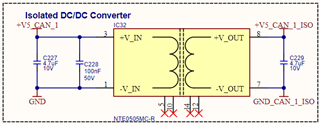Tool/software:
Hi
I have an ISO1042 circuit that I can't get to transmit or receive any CAN messages. It's a copy from a reference design so I'm a bit confused! One issue I see is that we are using NTE0505MC-B transformers to isolate the +5V and GND, and are seeing 5.67V on the output of this, which is higher than the max recommended for VDD2 according to the datasheet. Could this be the reason for the transceiver not working?



